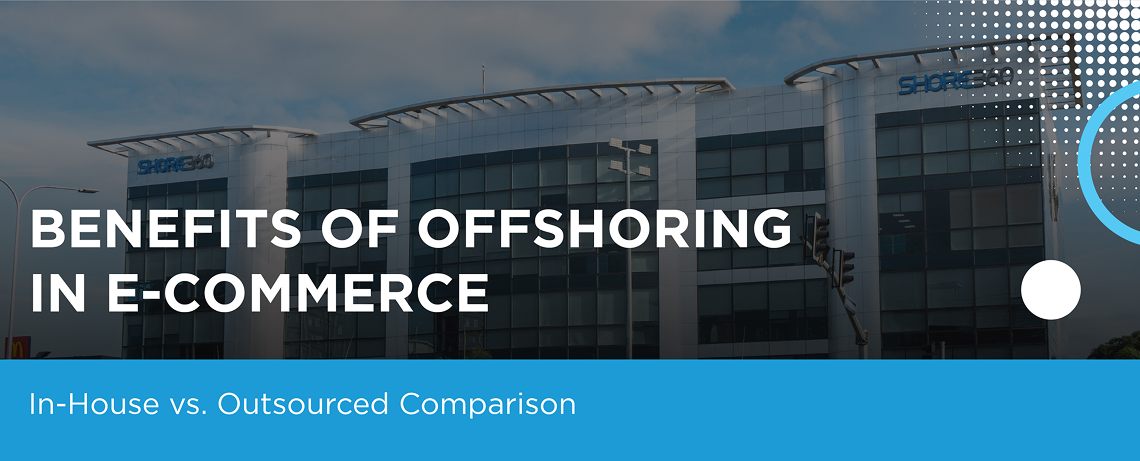Benefits of Offshoring
in E-Commerce
In-House vs. Outsourced Comparison

Offshore outsourcing has become a strategic advantage in the e-commerce industry, allowing businesses to streamline operations, reduce costs, and improve efficiency by outsourcing non-core or labour-intensive tasks. The Philippines has risen as a leading offshoring destination for businesses in the United States, Australia, New Zealand, and beyond, offering a skilled, English-speaking workforce at significantly lower labour costs. Companies that offshore to the Philippines can save 50–70% compared to local hiring costs, making it an ideal option for optimising operations, boosting profitability, and scaling effectively.
E-commerce businesses that offshore to the Philippines can typically enjoy significant cost savings (depending on the arrangement with the offshoring provider) on operational expenses, while maintaining high-quality service and expertise. At Shore360, we help our clients find skilled Filipino talent in the five key areas of e-commerce operations commonly offshored: Merchandising, Development, Photography, Customer Service, and Marketing. This approach provides a detailed comparison of in-house vs. outsourced models for each function, highlighting the benefits of offshoring in terms of efficiency, scalability, and cost-effectiveness.
Read on to analyse the benefits and challenges of outsourcing these functions. We will provide you with an overview of the possible impact of offshoring on e-commerce businesses.

Offshore e-commerce merchandising involves managing product listings, descriptions, pricing, and presentation to deliver a seamless and optimised shopping experience. Without consistent oversight and strategic optimisation, businesses risk inaccurate listings, poor categorisation, and inconsistent branding—factors that can negatively affect conversions. Partnering with a dedicated offshore team ensures that product catalogues remain accurate, visually appealing, and aligned with evolving market trends, ultimately boosting visibility and driving sales.
In-House Merchandising
An in-house merchandising team offers full control over product presentation, ensuring brand consistency and the ability to make quick adjustments. However, this control also presents significant challenges that can hinder efficiency and growth.
Scalability is one of the primary issues—as product catalogues expand or seasonal demands increase, in-house teams often struggle to keep up, resulting in delays, errors, and missed sales opportunities. The costs associated with hiring, training, and retaining skilled e-commerce merchandisers, product SEO specialists, and content managers add financial strain, particularly for smaller businesses. Without expertise in analytics and specialised SEO, product listings may lose visibility, which can lead to a decline in search rankings and conversions—a challenge that is often difficult to overcome.
Moreover, maintaining an internal merchandising team means absorbing high overhead costs, such as salaries, benefits, office space, and software licences—even during slower periods. Burnout, inefficiencies, and limited access to advanced e-commerce tools can further undermine the team’s ability to optimise product listings effectively. These bottlenecks slow down agility, making it challenging for businesses to scale quickly and stay competitive in the fast-paced e-commerce market.
Outsourced Merchandising in the Philippines
Outsourcing merchandising tasks—such as product listing creation, content optimisation, and inventory data management—does not mean losing control. Instead, businesses can build a dedicated offshore team in the Philippines that seamlessly integrates with existing operations. These professionals align with workflows and objectives, ensuring consistency and efficiency in merchandising processes.
Cost efficiency is a key advantage of offshoring. Filipino e-commerce specialists bring expertise in SEO, product catalogue management, and platform-specific optimisation (Amazon, Shopify, etc.), eliminating the need for expensive in-house training while maintaining high-quality listings. Their specialised knowledge ensures product visibility and conversion-driven strategies, keeping your store competitive.
Scalability improves significantly. Offshore teams handle high-volume, repetitive tasks—such as bulk product updates and inventory data management—allowing in-house staff to focus on strategic growth initiatives. The flexibility to scale resources up or down based on seasonal demand ensures businesses remain agile without excessive overhead costs.
Brand consistency and objectivity improve with a dedicated offshore merchandising team. They maintain uniform quality across listings, ensure accurate product information, and follow best practices without internal biases that might affect product prioritisation.
Outsourcing merchandising creates more than just cost savings. It establishes a strategic partnership that streamlines processes, enhances operational efficiency, and fuels long-term scalability. Many companies that have embraced this model have expanded their product offerings profitably, keeping costs lean while achieving higher efficiency and stronger profit margins.
E-Commerce Offshoring Tip

Building and maintaining an e-commerce platform presents significant challenges without offshore support, including high development costs, slow project timelines, and technical limitations. Hiring in-house developers can strain budgets, particularly for small to mid-sized businesses, while limited expertise in platforms like Shopify, Magento, or WooCommerce can result in integration issues, poor site optimisation, and sluggish performance that impact conversions. Scalability also becomes a concern, as in-house teams may struggle to handle seasonal demand spikes, platform updates, or new feature rollouts efficiently. Additionally, businesses lacking technical expertise often face difficulties in seamlessly integrating third-party tools like payment gateways, logistics solutions, and automation software, leading to operational bottlenecks and customer experience issues. Without a cost-effective, scalable approach, businesses risk delayed growth, inefficiencies, and missed revenue opportunities in an increasingly competitive e-commerce landscape.
In-House Development
While in-house software development offers complete control, it also demands significant investment and ongoing resource management, which can quickly become overwhelming for businesses. Recruiting and retaining skilled developers in competitive job markets like Australia and the U.S. is both expensive and time-consuming, with salaries often exceeding six figures, plus additional costs for benefits, bonuses, and career development. The challenge intensifies as the demand for specialised talent grows—finding experts in specific e-commerce platforms, programming languages, or automation technologies can lead to months-long hiring processes, stalling progress and innovation. However, this can be efficiently managed by your offshoring provider, such as Shore360, saving you both time and resources.
Beyond hiring, maintaining an internal team requires heavy operational expenses, including office space, high-performance equipment, software licences, and IT infrastructure. These fixed costs persist regardless of workload fluctuations, leading to inefficiencies when development needs to slow down but salaries and operational costs remain unchanged. This rigid structure makes it difficult to scale—businesses may find themselves understaffed during peak development cycles and overstaffed during maintenance phases, leading to burnout or wasted resources.
Additionally, an in-house team’s capabilities are limited to the expertise available within the company, restricting businesses from quickly adapting to new technologies or shifting development priorities. If a company suddenly requires migration to a new e-commerce platform or integration of AI-driven tools, the lack of specialised knowledge forces businesses to either delay projects or spend more on external consultants, contradicting the purpose of an internal team.
Security and intellectual property protection are often cited as benefits of in-house development, but without the right security protocols and expertise in cybersecurity, even internal teams remain vulnerable to data breaches, inefficiencies, and outdated security measures. Without a cost-effective, scalable, and flexible approach, businesses relying solely on in-house development risk falling behind competitors who leverage global talent for agility, innovation, and cost savings.
Outsourced Development in the Philippines
Outsourcing e-commerce development to the Philippines presents a strategic solution to effectively tackle talent shortages and cost challenges. Many companies choose this model for its key benefits, particularly the ability to access a global talent pool of Filipino developers. Offshore outsourcing eliminates geographic limitations, enabling businesses to tap into some of the world’s top experts. The Philippines has rapidly expanded its IT and development workforce, with numerous university graduates specialising in computer science and engineering.
Filipino developers are highly regarded for their strong proficiency in English and cultural compatibility, which promotes smoother communication with Western clients and reduces misunderstandings when discussing project requirements. This cultural alignment and language fluency make working on complex software projects far more seamless compared to other outsourcing destinations, ensuring more efficient and successful outcomes for e-commerce development initiatives.
In addition to talent, cost savings are a significant advantage. Labour costs for developers in the Philippines are typically lower than in countries like the U.S. or Australia. Even when the hourly rate for highly skilled developers is closer to other regions, our clients often find that “the quality of work combined with excellent communication skills…justifies the investment,” resulting in a better price-to-quality ratio. Furthermore, offshoring providers like Shore360 manage HR and infrastructure costs, including office space, hardware, and administrative support, allowing companies to pay a negotiated rate and avoid the overhead expenses of expanding an internal IT department. This enables businesses to focus purely on development work.
Another major benefit of outsourcing is scalability and flexibility. Outsourcing functions as an on-demand service, allowing businesses to quickly scale their development team up or down based on project needs. For example, if there’s a need to accelerate a new feature rollout, the vendor can allocate additional developers. Conversely, during maintenance phases, the team size can be reduced. Achieving this level of flexibility in-house would require hiring or layoffs, adding complexity. Outsourcing allows e-commerce companies to respond to market opportunities faster, without the long-term commitment to a full-time internal team. Studies show that many companies turn to outsourcing for this flexibility, as it enables them to “adjust their contract requirements freely” and add or remove specialists as needed.
Overall, outsourcing e-commerce development to the Philippines provides businesses with access to a skilled talent pool, cost savings, scalability, and flexibility, all of which contribute to more efficient operations and faster responses to market demands.
Offshoring E-Commerce Tip

High-quality product images significantly influence customer trust and purchasing decisions, making professional product photography essential for e-commerce success. However, managing in-house photography can be time-consuming, expensive, and resource-intensive, requiring skilled photographers, high-end equipment, and dedicated studio space. Capturing, editing, and organising large volumes of images can overwhelm internal teams, leading to delays in product launches and inconsistencies in branding. Outsourcing product photography and editing enables businesses to reduce operational costs, streamline workflows, and maintain consistent, high-quality visuals. Skilled graphic designers and photo editors—proficient in Adobe Photoshop, Lightroom, and advanced retouching techniques—optimise images for maximum engagement and conversions, ensuring products stand out in a competitive marketplace.
In-House Photography
Running an in-house product photography studio may seem like the ideal way to maintain brand consistency and control, but it quickly becomes a costly and resource-intensive burden. The initial investment is steep, requiring high-end cameras, lighting equipment, dedicated studio space, and editing software, all of which demand ongoing maintenance, upgrades, and repairs. Beyond equipment, hiring and retaining skilled photographers, stylists, and editors adds significant financial strain, as salaries, benefits, and training costs accumulate over time.
Even with the right team in place, managing in-house photography becomes a logistical challenge. The time required to build expertise and refine processes can slow operations, leading to delayed product launches and inconsistent image quality. Teams may struggle to keep up with high-volume shoots during peak seasons, while the studio sits underutilised during slower periods, wasting resources. Additionally, handling large or delicate products requires dedicated storage and extra precautions, further increasing costs.
With so many moving parts, running an in-house studio demands constant oversight and management attention, draining time and company resources. For many e-commerce businesses, this rigid structure limits flexibility and scalability, making it difficult to adapt to fluctuating demands. Outsourcing product photography offshore eliminates these challenges, providing access to skilled professionals, streamlined workflows, and significant cost savings. Leveraging offshore teams enables businesses to reduce operational stress, cut costs, and maintain high-quality visuals without the ongoing investment and management headaches of an in-house studio.
Outsourced Photography in the Philippines
Outsourcing product photography and editing to the Philippines, specifically in the Clark Freeport Zone, offers a streamlined and cost-effective solution for e-commerce businesses looking to maintain high-quality visuals without the complexities of in-house operations. These providers come equipped with fully operational studios, skilled photographers, and experienced editors who deliver professional-grade images with quick turnaround times, ensuring product listings remain visually appealing and competitive.
The flexibility and affordability of outsourcing make it an ideal alternative to managing in-house studios. Instead of bearing the fixed costs of salaries, equipment, and studio maintenance, businesses only pay per image or project, adjusting their photography needs as required. For companies with frequent or large-scale product updates, staff leasing in the Philippines offers a hybrid model, allowing businesses to hire dedicated offshore professionals while maintaining full control over workflows at a fraction of the local cost.
The Philippines’ competitive labour market and 24/7 work capabilities further enhance efficiency. Offshore teams can complete bulk editing overnight, ensuring that product images are ready for the next business day. Tasks like background removal, colour correction, and retouching can be seamlessly offloaded, freeing up internal teams to focus on higher-value work like branding and marketing strategy.
Scalability is another key advantage. While in-house teams may struggle to handle seasonal spikes or large product catalogues, offshore partners can rapidly scale up production to accommodate hundreds or thousands of SKUs. Established outsourcing providers implement quality control processes, ensuring consistent, professional, and on-brand images—without the logistical and financial challenges of managing an in-house studio.
For businesses seeking to enhance efficiency, maintain top-tier product visuals, and scale seamlessly, outsourcing product photography and editing offers a highly effective, low-risk solution. This approach allows e-commerce brands to focus on growth while ensuring their products stand out in a competitive market.
Offshoring E-Commerce Tip
Freelancers in product photography present risks due to their lack of accountability, inconsistent brand alignment, and potential security concerns, as they are not bound by company policies. Without contractual obligations, freelancers can abandon projects, delay work, or fail to maintain visual consistency. Additionally, sensitive assets like product prototypes may face intellectual property risks.
However, by working with a structured offshore team, businesses can invest the necessary time upfront in training, aligning with the brand vision, and conducting regular check-ins to ensure full brand integration. Through coaching, guidance, and consistent communication, offshore teams can evolve into brand experts, delivering reliable, high-quality results that stay true to the company’s identity.

Managing customer service in-house is costly, inefficient, and difficult to scale, particularly as businesses grow and customer enquiries increase across multiple channels like phone, email, and live chat. Providing 24/7 support requires a large workforce, significantly raising operational costs. Hiring, training, and retaining an internal team adds to the financial burden.
Fluctuating demand further complicates matters—during peak seasons, long wait times can frustrate customers and lead to lost sales, while in slower periods, maintaining a full team becomes an unnecessary overhead cost. Ensuring consistent brand voice, accurate product knowledge, and high service standards is another challenge, as poorly trained or overburdened staff may deliver inconsistent messaging, resulting in lower customer satisfaction.
With rising expectations for fast, reliable support, businesses struggling to balance cost, quality, and scalability risk losing customers to competitors with more efficient service models.
In-House Customer Service
Keeping customer service in-house may seem like the best way to maintain control over quality and brand alignment, but it comes with significant challenges that can quickly become overwhelming for growing e-commerce businesses. While an internal team ensures direct communication with customers and seamless coordination with other departments, the high costs, scalability issues, and operational inefficiencies often outweigh the benefits.
The financial burden is substantial. Hiring, training, and managing a customer support team—especially one that offers extended hours or 24/7 coverage—requires a significant investment. In high-cost markets like the U.S. or Australia, a single call centre agent earns approximately $2,692 per month. Ensuring full coverage across time zones further multiplies this expense. Beyond wages, companies also bear the cost of infrastructure, including telephony systems, office space, benefits, and ongoing training—all of which quickly add up.
Scalability is another major issue. E-commerce businesses face unpredictable fluctuations in customer service demand. Peak seasons, flash sales, and unexpected surges in enquiries can overwhelm an in-house team, leading to long wait times, frustrated customers, and increased churn. On the other hand, during off-peak periods, agents remain underutilised, yet businesses still pay their full salaries. Striking a balance between having enough staff during peak periods and avoiding resource wastage during slower times is an ongoing challenge.
Limited global reach can also hinder growth. If an in-house team is based in only one or two regions, providing multilingual support or covering international time zones effectively becomes nearly impossible. As businesses expand into new markets, the lack of localised support can hurt customer satisfaction and brand reputation. Meanwhile, global competitors with outsourced teams offering 24/7 multilingual service are better positioned to address diverse customer needs.
For businesses prioritising cost efficiency, scalability, and seamless global support, relying solely on an in-house team can quickly become unsustainable—especially in a rapidly evolving e-commerce landscape where customer expectations are higher than ever.
Outsourced Customer Service (Philippines)
The Philippines is widely recognised as the “Call Centre Capital of the World,” offering businesses a highly effective and cost-efficient customer service solution with impeccable quality assurance. Companies that outsource to the Philippines gain a competitive advantage through cost savings, a skilled workforce, and scalable support.
Outsourcing customer service to the Philippines can reduce costs by up to 60–70% compared to hiring in Western countries. A full-time Filipino call centre agent costs around $1,000 per month, whereas a U.S.-based agent can cost nearly $2,700, excluding benefits and infrastructure. Many outsourcing providers cover equipment, training, and operational expenses, making it an all-inclusive, budget-friendly option. These savings allow businesses to reinvest in growth areas like marketing, product development, or customer loyalty programmes.
Filipino customer service agents are known for their exceptional English proficiency, neutral accents, and strong cultural alignment with Western markets. The country’s 97% literacy rate, combined with an education system that prioritizes English, makes it an ideal destination for customer-facing roles. Additionally, the Filipino culture emphasizes hospitality and service, ensuring agents provide empathetic, friendly, and professional interactions, which directly improves customer satisfaction and brand reputation.
A major advantage of outsourcing to the Philippines is the ability to scale teams up or down effortlessly. Companies can quickly expand their customer support workforce during peak shopping seasons or product launches without the burden of long-term commitments. Conversely, during slower periods, they can adjust staffing levels without layoffs. Additionally, most outsourcing providers in the Philippines operate on a 24/7 schedule, ensuring round-the-clock customer service coverage, boosting response times, and enhancing customer trust in global markets.
Outsourcing customer service to the Philippines isn’t just a cost-saving measure—it’s a strategic decision that enhances service quality, supports business scalability, and strengthens brand loyalty.
Offshoring E-Commerce Tip

Effective marketing is essential for e-commerce success, yet building and maintaining an in-house marketing team presents significant challenges. Hiring skilled professionals for diverse areas such as SEO, PPC, social media management, and content creation requires a substantial financial investment. In competitive markets like the U.S. and Australia, salaries for digital marketing experts are high, making it difficult for smaller businesses to afford a well-rounded, specialised team. Additionally, as digital marketing evolves rapidly, keeping up with algorithm changes, emerging trends, and new tools demands continuous training and upskilling—another costly and time-consuming process. In-house teams also face scalability issues; during slow periods, staff may be underutilised, whereas, during peak seasons, the workload can become overwhelming, leading to burnout and inefficiencies. Without the right expertise or ability to scale efficiently, businesses risk falling behind competitors and missing crucial opportunities for growth in an increasingly digital marketplace.
In-House Marketing
An in-house marketing team is highly familiar with the brand, products, and target audience, which ensures alignment between campaigns and company goals. This close connection allows for fast adjustments to campaigns and messaging, with immediate access to product teams or executives. In-house marketers have full control over the brand voice, ensuring consistency across content like ads, tweets, and blog posts. This internal alignment also enables quick reactions in situations like a PR crisis or seizing an opportunity from a trending topic.
Moreover, any proprietary data or insights stay within the company, preserving a competitive edge. In-house marketers also develop a deeper long-term commitment to the brand, understanding its story and vision, which is hard to replicate with external teams. In niche industries, in-house experts may be more knowledgeable about product details and regulatory constraints.
However, maintaining an in-house marketing team can be costly and limited in scope. With the diverse range of marketing functions today, it’s unrealistic for a small team to excel in all areas (e.g., SEO, Google Ads, social media, copywriting, etc.). Hiring specialists for each area is expensive and often impractical, leaving in-house teams covering multiple roles without the specialised skills needed. Recruiting and retaining experienced marketers, especially in competitive markets, adds further costs. Additionally, marketing needs fluctuate, and during off-peak times, a full in-house team may be underutilised but salaries still need to be paid.
Outsourced Marketing (Philippines)
The Philippines is widely recognised as the “Call Centre Capital of the World,” offering businesses a highly effective and cost-efficient customer service solution with impeccable quality assurance. Companies that outsource to the Philippines gain a competitive advantage through cost savings, a skilled workforce, and scalable support.
Outsourcing customer service to the Philippines can reduce costs by up to 60–70% compared to hiring in Western countries. A full-time Filipino call centre agent costs around $1,000 per month, whereas a U.S.-based agent can cost nearly $2,700, excluding benefits and infrastructure. Many outsourcing providers cover equipment, training, and operational expenses, making it an all-inclusive, budget-friendly option. These savings allow businesses to reinvest in growth areas like marketing, product development, or customer loyalty programmes.
Filipino customer service agents are known for their exceptional English proficiency, neutral accents, and strong cultural alignment with Western markets. The country’s 97% literacy rate, combined with an education system that prioritizes English, makes it an ideal destination for customer-facing roles. Additionally, the Filipino culture emphasizes hospitality and service, ensuring agents provide empathetic, friendly, and professional interactions, which directly improves customer satisfaction and brand reputation.
A major advantage of outsourcing to the Philippines is the ability to scale teams up or down effortlessly. Companies can quickly expand their customer support workforce during peak shopping seasons or product launches without the burden of long-term commitments. Conversely, during slower periods, they can adjust staffing levels without layoffs. Additionally, most outsourcing providers in the Philippines operate on a 24/7 schedule, ensuring round-the-clock customer service coverage, boosting response times, and enhancing customer trust in global markets.
Outsourcing customer service to the Philippines isn’t just a cost-saving measure—it’s a strategic decision that enhances service quality, supports business scalability, and strengthens brand loyalty.
Potential Disadvantages
However, by investing upfront in structured onboarding, brand training, and ongoing engagement, offshore teams can develop a deep understanding of the brand voice and target audience. With dedicated offshore marketing teams in the Philippines, businesses can assign real-time marketing responsibilities strategically, ensuring timely execution of campaigns without being constrained by time zone differences.
Conclusion

Outsourcing e-commerce functions to the Philippines offers substantial value for businesses, particularly in Western markets. The cost savings are significant—operations can be run at 30%–50% less than in-house, thanks to lower wages and bundled overhead costs. Beyond the cost savings, your business can also benefit from increased efficiency and access to skilled talent. Filipino teams excel in key e-commerce functions, including customer service, development, and creative tasks like product listings and marketing.
While in-house teams are still essential for strategic roles and brand oversight, outsourcing tasks like merchandising, IT, photography, and support offers increased flexibility. Common outsourcing concerns, such as communication gaps or oversight challenges, can be mitigated with clear processes, strong partnerships, and by working with reputable providers. The Philippines’ established BPO industry, with over 1.3 million professionals, ensures smooth and reliable collaboration.
Shore360 has partnered with numerous e-commerce companies in Australia and the U.S., helping them set up offshore teams in the Philippines and reap the benefits of this cost-effective and scalable solution.
To learn more about how we help businesses set up successful offshore teams, visit https://www.shore360.com/whats-right-for-you/ to discover more about our services and how we can support your e-commerce operations.
References
- BairesDev. (n.d.). Software outsourcing vs. in-house development: Pros and cons. BairesDev. Retrieved from https://bairesdev.com
- Cynergy BPO. (n.d.). 6 ways retail outsourcing to the Philippines reduces costs. Cynergy BPO. Retrieved from https://cynergybpo.com
- FotoMachina. (n.d.). In-house vs outsourcing product photography: Which is better? FotoMachina. Retrieved from https://fotomachina.ph
- HireEcom. (n.d.). Outsourcing ecommerce development: India vs. Philippines. HireEcom. Retrieved from https://hireecom.com
- KDCI Outsourcing. (n.d.). Guide to outsourcing digital marketing to the Philippines. KDCI Outsourcing. Retrieved from https://kdci.co
- KDCI Outsourcing. (n.d.). Pros & cons of outsourcing customer service to the Philippines. KDCI Outsourcing. Retrieved from https://kdci.co
- Magellan Solutions. (n.d.). 7 amazing cases of outsourcing customer service Philippines. Magellan Solutions. Retrieved from https://magellan-solutions.com
- MatchBoard. (n.d.). Advantages & disadvantages of outsourcing to the Philippines. MatchBoard. Retrieved from https://matchboard.com.au
- Outsource-Philippines. (n.d.). Top benefits of ecommerce outsourcing for your online business. Outsource-Philippines. Retrieved from https://outsource-philippines.com
- Unity Communications. (n.d.). E-commerce support case study. Unity Communications. Retrieved from https://unity-connect.com
- Unity Connect. (n.d.). All you need to know about outsourcing e-commerce product listing processes. Unity Connect. Retrieved from https://unity-connect.com
- Unity Connect. (n.d.). Examples of outsourcing companies in the Philippines. Unity Connect. Retrieved from https://unity-connect.com

